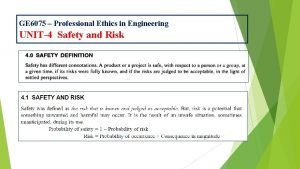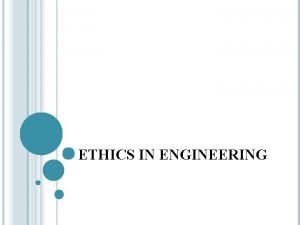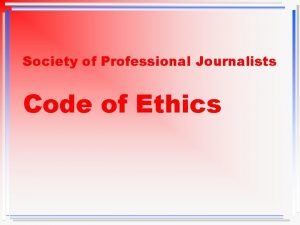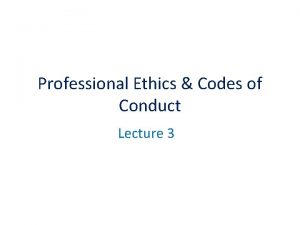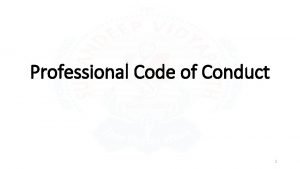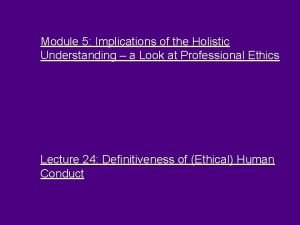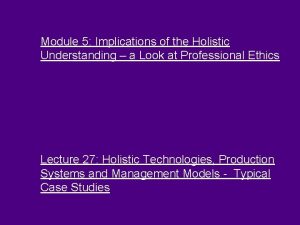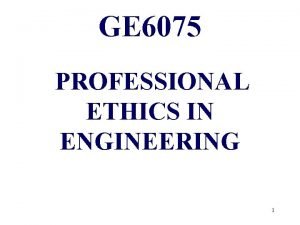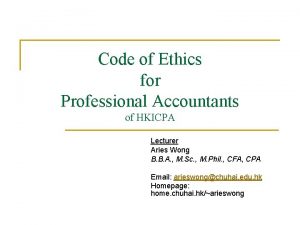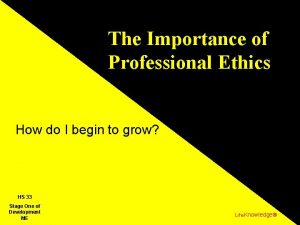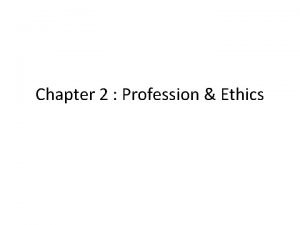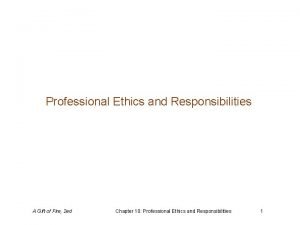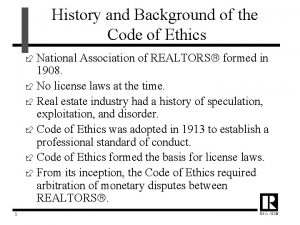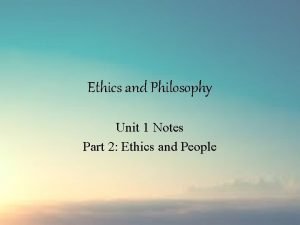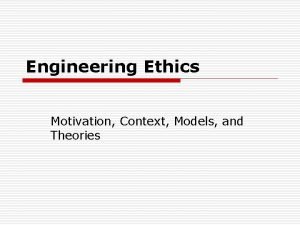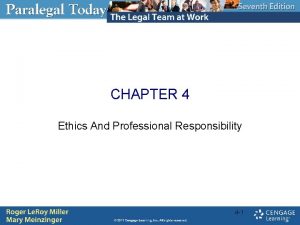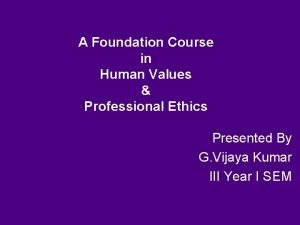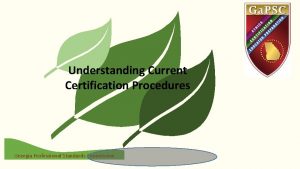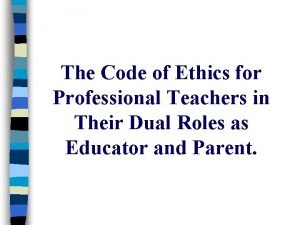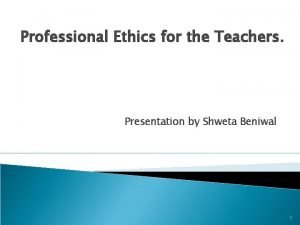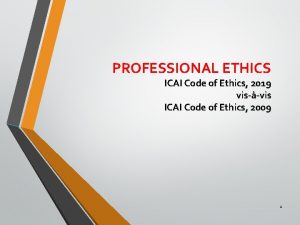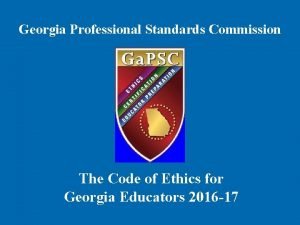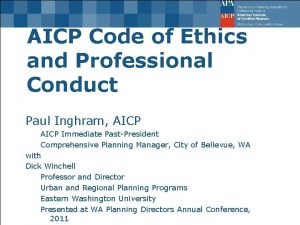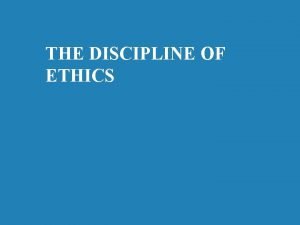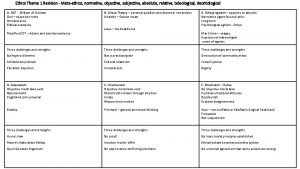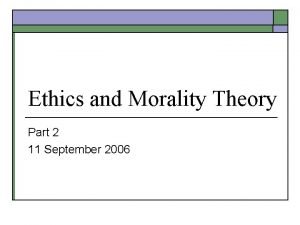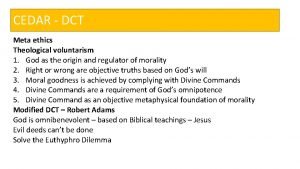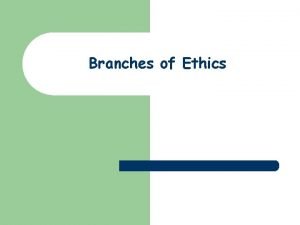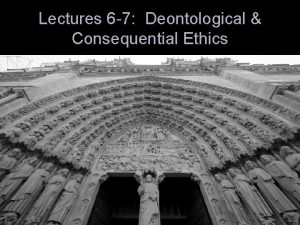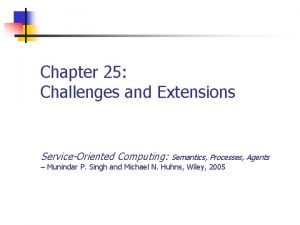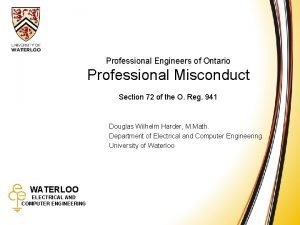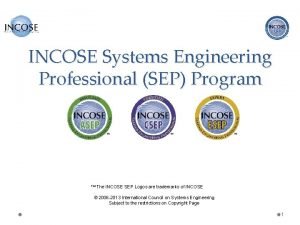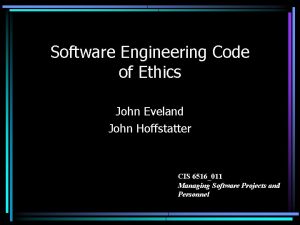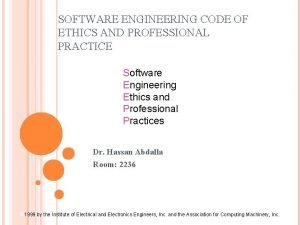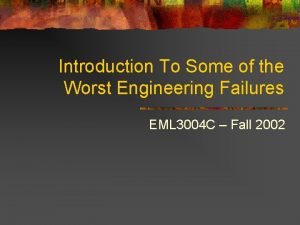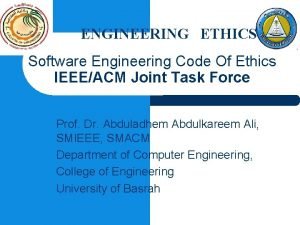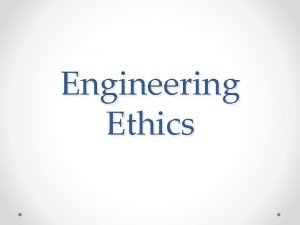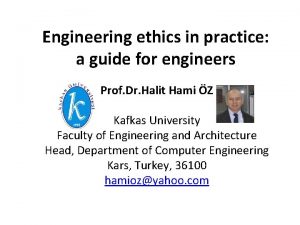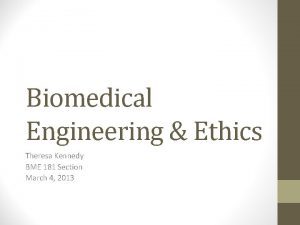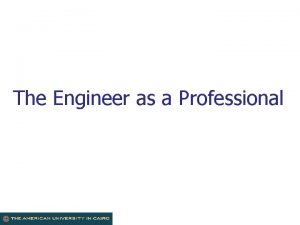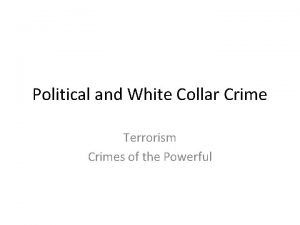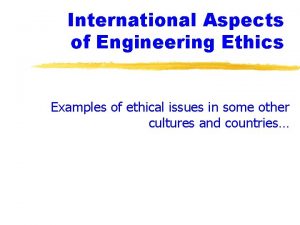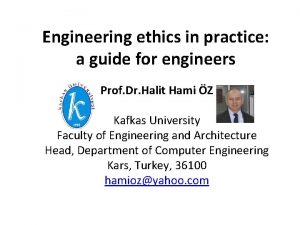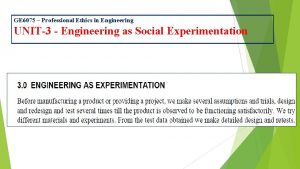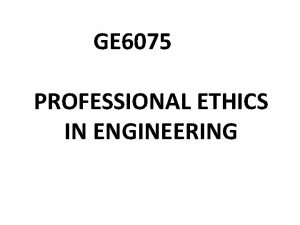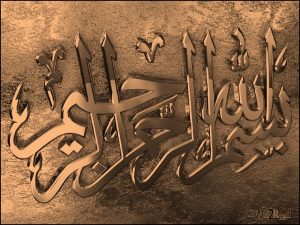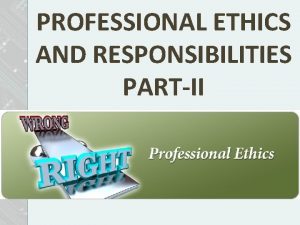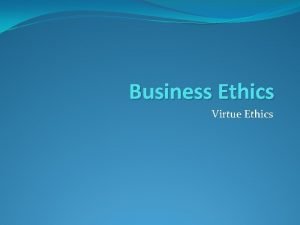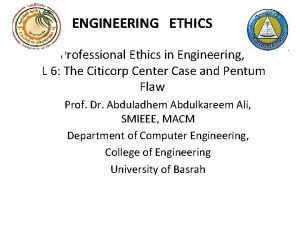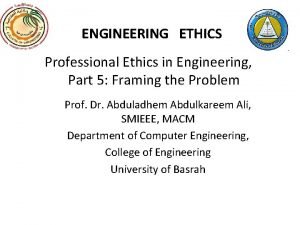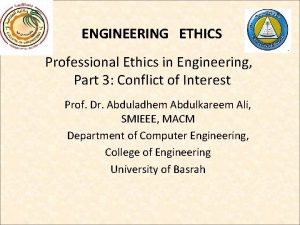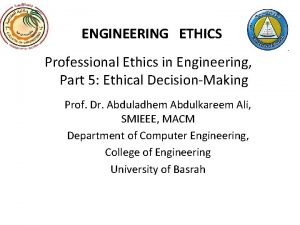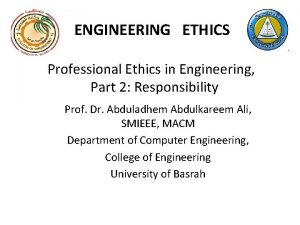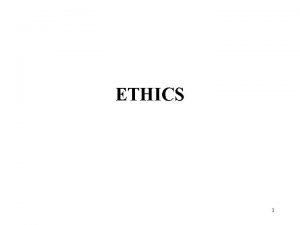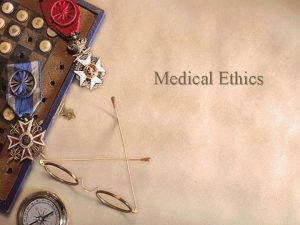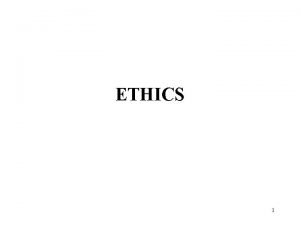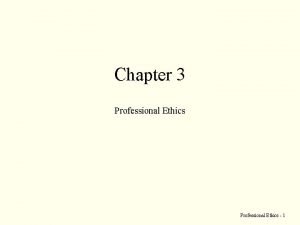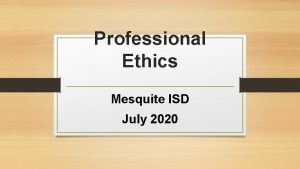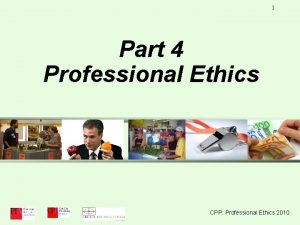GE 6075 PROFESSIONAL ETHICS IN ENGINEERING UNIT2 ENGINEERING

































































- Slides: 65

GE 6075 PROFESSIONAL ETHICS IN ENGINEERING UNIT-2 ENGINEERING ETHICS

GE 6075 PROFESSIONAL ETHICS IN ENGINEERING UNIT I - HUMAN VALUES Morals, values and Ethics – Integrity – Work ethic – Service learning – Civic virtue – Respect for others – Living peacefully – Caring – Sharing – Honesty – Courage – Valuing time – Cooperation – Commitment – Empathy – Self-confidence – Character – Spirituality – Introduction to Yoga and meditation for professional excellence and stress management.

Time as a resource What is time management: limited time is always used effectively in life Identifying time wasters: unscheduled and scheduled meeting Lack of adequate planning Poor delegation Too much socializing, ineffective commn, assuming unnecessary public responsibilities, lack of goals and objectives, poorly organized supervision, poor use of telephone

Time management principle: Clear objective Prioritize tasks Stick to scheduled tasks Allow time to manage your time: allocate a slot of time for time management The unexpected: expect the job Managing time wasters


UNIT – II ENGINEERING ETHICS 6

Department of Information Technology GE 6075 PROFESSIONAL ETHICS IN ENGINEERING UNIT 2 ENGINEERING ETHICS 96 Senses of ‘Engineering Ethics’-Variety of Moral Issues -Types Of Inquiry-Moral Dilemmas- Moral Autonomy -Kohlberg’s Theory-Gilligan’s Theory-Consensus And Controversy- Professions And Professionalism. Professional Ideals And Virtues-Theories About Right Action-Self-Interest-Customs And Religion-Uses Of Ethical Theories. 7

CONTENTS Senses of ‘Engineering Ethics’ Variety of Moral Issues Types of inquiry Moral dilemmas Moral autonomy Kohlberg’s theory Gilligan’s theory Professions and professionalism Professional ideals and virtues Theories about right action Self-interest Customs and religion Uses of ethical theories 8

SENSES OF ETHICS • • Ethics is an activity of – Understanding the moral values – Resolve the moral issues – Justify the moral judgment Ethics refers to a set of beliefs, attitudes, and habits that a person or group displays Concerning morality. Ethics is a purely factual matter about explaining beliefs and actions related to morality. Ethics refers to being “morally correct” – People’s action can be spoken as “ethical” or “unethical” – Individuals can be evaluated as “ethical” or “unethical” 9

WHAT IS ENGINEERING ETHICS Engineering activity of Ethics is an Understanding the moral values that ought to guide the engineering profession Resolve the moral issues in the profession Justify the moral judgment concerning the profession. 10

Department of Information Technology MORALITY Morality is concerned with principles and practices of morals such as: What ought or ought not to be done in a given situation? What is right or wrong about the handling of a situation? What is good or bad about the people, policies, and ideals involved? 11

MORALITY VS. ETHICS 12

MORAL REASONING • “Engineering design is a good one” – Meets Specifications – Technical Value – Specifications has moral content - Moral Reasons • Designed in such a way that a safe, reliable and environmental friendly product can be produced • Moral Reasons – Require us to respect other people as well as ourselves, to care for their good as well as their own Respecting persons by being fair and just with them, respecting their rights, keeping promises, avoiding unnecessary offense and pain to them, avoiding cheating and dishonesty 13

VARIETY OF MORAL ISSUES Two Approaches to engineering ethics: Typical, everyday problems that can take on significant proportions in and engineer’s life Societal Problems that are often shunted aside and are not addressed until they unexpectedly resurface 14

HOW DO MORAL PROBLEMS ARISE IN ENGINEERING • • Examples – Faculty construction equipment – Applying for a permit to operate a nuclear power plant – Chemical plant dumping wastes in a landfill – Advertisements from an electronic company for a product which is not ready for sale Engineer might be faced with contrary opinions – Within the firm – From the client – From other firms within the industry 15

CHALLENGES ON HANDLING MORAL ISSUES To what extent can a supervisor be an authoritative guide to engineer’s conduct ? Ø What does one do when there are differences of judgement ? Ø Should one always follow the law to the letter? Ø Is an engineer to do no more than what the specifications say, even if there are problems more serious than those initially anticipated? Ø How far does an engineer’s responsibility extend into the realm of influencing the social impact of the projects he or she participates in? Ø 16

TYPES OF INQUIRIES The three types of inquiries, in solving ethical problems are: Normative inquiry Conceptual inquiry Factual or descriptive inquiry 17

NORMATIVE INQUIRY It seeks to identify and justify the morally-desirable norms or standards that should guide individuals and groups. It also has theoretical goal of justifying particular moral judgments. 18

Example: NORMATIVE INQUIRY How far does the obligation of engineers to protect public safety extend in any given situation? When, if ever, should engineers be expected to blow whistle on dangerous practices of their employers? Whose values ought to be primary in making judgment about acceptable risks in design for a public transport system or a nuclear plant? Is it of management, senior engineers, government, voters or all of them? When and why is the government justified in interfering with the organizations? What are the reasons on which the engineers show their obligations to their employees or clients or the public? 19

CONCEPTUAL INQUIRY • • It is directed to clarify the meaning of concepts or ideas or principles that are expressed by words or by questions and statements. Examples: – – • What is meant by safety? How is it related to risk? What is a bribe? What is a profession? When moral concepts are discussed, normative and conceptual issues are closely interconnected. 20

FACTUAL OR DESCRIPTIVE INQUIRY • • • It is aimed to obtain facts needed for understanding and resolving value issues. Researchers conduct factual inquiries using mathematical or statistical techniques. The inquiry provide important information on business realities, engineering practice, and the effectiveness of professional societies in fostering moral conduct, the procedures used in risk assessment, and psychological profiles of engineers. 21

Factual or Descriptive Inquiry • The facts provide not only the reasons for moral problems but also enable us to develop alterative ways of resolving moral problems. • Example 1. How were the benefits assessed? 2. What are procedures followed in risk assessment? 3. What are short-term and long-term effects of drinking water being polluted? 4. Who conducted the tests on materials? Department of Information Technology 22

MORAL DILEMMA • Dilemmas are situations in which – – Moral reasons come into conflict The application of moral values are problems, and one is not clear of the immediate choice or solution of the problems. Moral reasons could be rights, duties, goods or obligations. These situations do not mean that things had gone wrong, but they only indicate the presence of moral complexity. This makes the decision making complex. 23

SITUATIONS LEADING TO MORAL DILEMMA The three complex situations leading to moral dilemmas are: The problem of vagueness • One is unable to distinguish between good and bad (right or wrong) principle. Good means an action that is obligatory. For example, code of ethic specifies that one should obey the laws and follow standards. Refuse bribe or accept the gift, and maintain confidentiality 24

Situations leading to Moral Dilemma The problem of conflicting reasons • One is unable to choose between two good moral solutions. One has to fix priority, through knowledge or value system. The problem of disagreement • There may be two or more solutions and none of them mandatory. These solutions may be better or worse in some respects but not in all aspects. One has to interpret, apply different morally reasons, and analyze and rank the decisions. Select the best suitable, under the existing and the most probable conditions. 25

STEPS TO SOLVE DILEMMA • • • Identification of the moral factors and reasons. Collection of all information, data, and facts Rank the moral options Generate alternate courses of action to resolve the dilemma Discuss with colleagues and obtain their perspectives, priorities, and suggestions on various alternatives Decide upon a final course of action, based on priority fixed or assumed 26

MORAL AUTONOMY • • Moral autonomy is defined as, decisions and actions exercised on the basis of moral concern for other people and recognition of good moral reasons. Alternatively, moral autonomy means ‘self determinant or independent’. The autonomous people hold moral beliefs and attitudes based on their critical reflection rather than on passive adoption of the conventions of the society or profession. Moral autonomy may also be defined as a skill and habit of thinking rationally about the ethical issues, on the basis of moral concern. 27

MORAL AUTONOMY If management views profitability is more important than consistent quality and retention of the customers that discourage the moral autonomy, engineers are compelled to seek the support from their professional societies and outside organizations for moral support. 28

KOHLBERG THEORY Kohlberg suggested there are three levels of moral development, based on the type of reasoning and motivation of the individuals in response to moral questions Pre-conventional Conventional Post-conventional 29

Pre-Conventional – – – Right conduct for an individual is regarded as whatever directly benefits oneself. At this level, individuals are motivated by obedience or the desire to avoid punishment or to satisfy their own needs All young children exhibit this tendency. Conventional – People respect the law and authority Post Conventional – People begin to account for the differing values, opinions and beliefs of other people. 30

KOHLBERG THEORY • The following is one example of the dilemmas Kohlberg presented. "Heinz Steals the Drug” In Europe, a woman was near death from a special kind of cancer. There was one drug that the doctors thought might save her. It was a form of radium that a druggist in the same town had recently discovered. The drug was expensive to make, but the druggist was charging ten times what the drug cost him to make. He paid $200 for the radium and charged $2, 000 for a small dose of the drug. 31

Kohlberg Theory The sick woman's husband, Heinz, went to everyone he knew to borrow the money, but he could only get together about $ 1, 000 which is half of what it cost. He told the druggist that his wife was dying and asked him to sell it cheaper or let him pay later. But the druggist said: "No, I discovered the drug and I'm going to make money from it. " So Heinz got desperate and broke into the man's store to steal the drug-for his wife. Should the husband have done that? • Kohlberg was not interested so much in the answer to the question of whether Heinz was wrong or right, but in the reasoning for each participant's decision. The responses were then classified into various stages of reasoning in his theory of moral development.

KOHLBERG THEORY • Level 1. Preconventional Morality Stage 1 - Obedience and Punishment The earliest stage of moral development is especially common in young children, but adults are also capable of expressing this type of reasoning. At this stage, children see rules as fixed and absolute. Obeying the rules is important because it is a means to avoid punishment. Stage 2 - Individualism and Exchange At this stage of moral development, children account for individual points of view and judge actions based on how they serve individual needs. In the Heinz dilemma, children argued that the best course of action was the choice that best-served Heinz’s needs. Reciprocity is possible, but only if it serves one's own interests. 33

Kohlberg Theory • Level 2. Conventional Morality Stage 3 - Interpersonal Relationships often referred to as the "good boy-good girl" orientation, this stage of moral development is focused on living up to social expectations and roles. There is an emphasis on conformity, being "nice, " and consideration of how choices influence relationships. Stage 4 - Maintaining Social Order At this stage of moral development, people begin to consider society as a whole when making judgments. The focus is on maintaining law and order by following the rules, doing one’s duty and respecting authority. Department of Information Technology 34

• Level 3. Post conventional Morality Stage 5 - Social Contract and Individual Rights At this stage, people begin to account for the differing values, opinions and beliefs of other people. Rules of law are important for maintaining a society, but members of the society should agree upon these standards. Stage 6 - Universal Principles Kolhberg’s final level of moral reasoning is based upon universal ethical principles and abstract reasoning. At this stage, people follow these internalized principles of justice, even if they conflict with laws and rules. 35

GILLIGAN’S THEORY • • Gilligan observes that Kohlberg's stages were derived exclusively from interviews with males, and she charges that the stages reflect a decidedly male orientation. For males, advanced moral thought revolves around rules, rights, and abstract principles. The ideal is formal justice, in which all parties evaluate one another's claims in an impartial manner. This conception of morality, Gilligan argues, fails to capture the distinctly female voice on moral matters. 36

GILLIGAN’S THEORY Gilligan says morality centers not on rights and rules but on interpersonal relationships and the ethics of compassion and care. The ideal is not impersonal justice but more affiliative ways of living. Women's morality, in addition, is more contextualized; it is tied to real, ongoing relationships rather than abstract solutions to hypothetical dilemmas. 37

GILLIGAN’S THEORY Understanding the needs, interests, and welfare of another person, and understanding the relationship between oneself and that other requires a stance toward that person informed by care, love, empathy, compassion, and emotional sensitivity. It involves, for example, the ability to see the other as different in important ways from oneself, as a being existing in her own right, rather than viewing her through a simple projection of what one would feel if one were in her 38

KOHLBERG’S THEORY VS. GILLIGAN'S THEORY • • For Kohlberg the mode of reasoning which generates principles governing right action involves formal rationality alone. Emotions play at most a remotely secondary role in both the derivation and motivation for moral action. For Gilligan, by contrast, morality necessarily involves an intertwining of emotion, cognition, and action, not readily separable. Knowing what to do involves knowing others and being connected in ways involving both emotion and cognition. 39

CONSENSUS AND CONTROVERSY Consensus means agreement. Controversy means Disagreement. The ethics make the engineers realize the importance of tolerance among them in case of disagreement while applying moral autonomy. 40

Department of Information Technology OCCUPATION VS. PROFESSION • • • Profession can only be applied to certain occupations which meet the following criteria Knowledge: The work involves exercising sophisticated skills , theoretical knowledge and judgment and discretion that is not entirely routine or subject to mechanization. Organization: Special societies and organizations controlled by members of the profession are allowed by the public to play a major role in setting standards for admission to the profession. Public Good: The occupation serves some important aspects of public good as indicated in the codes of ethics. 41

MEMBERSHIP CRITERIA Earning bachelor’s degree in engineering at a school approved by the ABET. Performing commonly recognized as what engineers do. Being officially registered and licenses as a Professional Engineer(PE). Acting in morally responsible ways while practicing engineering. 42

MODELS OF PROFESSIONAL ROLES • • Savior: The representative engineer is a savior who will redeem society from poverty, inefficiency, waste and drudgery of manual labor. Guardian: The representative engineer knows the directions in which and pace at which, technology should develop. Accordingly they should be given positions of high authority based on their expertise in determining what is in the best interest of the society. 43

Models of Professional Roles • Bureaucratic servant: The role of engineer is to be a servant who receives and translates the directives of the management into concrete achievements. • Social servant: The role of engineers’ lies in obedient service to others but their true master is society. • Social enabler or catalyst: Ultimate power lies with the management. Nevertheless, the engineer plays a vital role beyond mere compliance with orders. • Game Player: Engineers are neither servants nor masters. They play by the economic game rules that happen to be in effect at a given time. 44

VIRTUE ETHICS Actions are considered right if they support good character traits (virtues) and wrong if they support bad character traits (vices) Closely tied to personal honor 45

THEORIES ABOUT VIRTUES Aristotle: Virtue and the Golden Mean Aristotle, the most influential of all virtue ethicist, defined the virtues as acquired habits that enable us to engage effectively in rational activities. Moral virtues are tendencies, acquired thro’ habit formation, to reach a proper balance between extremes in conduct, emotion, desire and attitude. Virtues are tendencies to find “The Golden Mean” between the extremes of too much and too little. E. g. Truthfulness is the mean between revealing all information in violation of tact 46 and confidentiality and being secretive.

THEORIES ABOUT VIRTUES Macintyre: Virtues and Practices Macintyre is a contemporary ethicist who has stimulated a renewed interest in virtue ethics and applied it to thinking about professional ethics. Macintyre begins with the idea of social practices. Cooperative activities aimed toward achieving public goods that could not otherwise be achieved, at least not to the same degree. These goods are internal to the practices in that they define what the practices are all about. They differ from external goods. E. g. The primary internal good of medicine is the promotion of health. 47

PROFESSIONAL RESPONSIBILITY is being morally responsible as a professional. is an umbrella virtue that encompasses a wide variety of more specific virtues that acquire importance in particular situations Many of the virtues can be grouped into four categories Self-direction virtues Public-spirited virtues Team-work virtues Proficiency virtues 48

INTEGRITY is the unity of character on the basis of moral concern, and especially on the basis of honesty. The unity is consistency among our attitudes, emotions and conduct in relation to justified moral values. Integrity makes possible the virtues of self-respect and pride in one’s work. 49

HONESTY Honesty has two aspects: Truthfulness Meeting responsibilities concerning truth-telling Trustworthiness Meeting responsibilities concerning trust. List of specific virtues that truthfulness and trustworthiness imply: Honesty in acts Honesty in speech Honesty in beliefs discretion 50

SELF RESPECT is valuing oneself in morally appropriate ways. takes two forms: Recognition self-respect Appraisal self-respect Specific virtues for self respect A sense of honor Self-control Courage Good judgment 51

SENSES OF RESPONSIBILITY Characteristic quality Obligations General moral capacity Liability and accountability 52

TYPES OF RESPONSIBILITY Moral responsibility Obligations Accountability Praiseworthy/Blameworthy Casual responsibility Legal responsibility 53

THEORIES ABOUT RIGHT ACTION Utilitarianism Duty Ethics Rights Ethics Virtue Ethics 54

UTILITARIANISM JOHN STUART MILL (1806 -1873) Considers a balance of good & bad consequences for everyone affected (society) Actions are good that serve to promote human well-being Cost-Benefit analysis is an application Consideration of most benefit to the most people outweighs needs of a few individuals 55

DUTY ETHICS IMMANUEL KANT (1724 -1804) There are duties that should be performed (e. g. . Duty to treat others fairly or not to injure others) regardless of whether these acts do the most good or not. 56

RIGHTS ETHICS JOHN LOCKE (1632 -1704) People have fundamental rights (like life, liberty, & property) that others have a duty to respect. 57

TESTING ETHICAL THEORIES Five widely used tests for evaluating ethical theories: The theory must be clear It must be consistent Neither theory nor its defense can rely upon false information It must be sufficiently comprehensive to provide guidance in specific situations of interest to us. It must be compatible with our most carefully considered moral convictions 58 about concrete situations

SELF-INTEREST AND ETHICAL EGOISM is being good and acceptable to oneself. It is pursuing what is good for oneself. It is very ethical to possess self-interest. A view that tries to reduce morality to the pursuit of self-interest is called ethical egoism. “Ethical “ because it is a theory about morality and “egoism” because it says that the sole duty of each of us is to maximize his or her own good. 59

CUSTOMS AND ETHICAL RELATIVISM Various culture in our pluralistic society lead to tolerance for various customs, beliefs and outlooks. Ethical pluralism is the view that there may be alternative perspectives that are reasonable, but no one of which must be accepted completely by all rational and morally concerned persons. Ethical relativism says that actions are morally right when they are approved by law or custom; they are wrong when they violate laws or customs. Moral rationalism is the view that moral judgments should be made in relation to factors that may vary from case to case. 60

RELIGION Religions have played major roles in shaping moral views and moral values. Each religion lays stress on certain high moral standards. Hinduism holds polytheistic view and virtues of devotion and surrender to high order. Christianity believes in one deity and emphasizes on virtues of love, faith and hope. Islam on one deity and adherence to ishan and prayer. But many religious sects have adopted poor moral standards. People are killed in the name of religion. 61

DIVINE COMMAND ETHICS As per this principle, the right action is defined by the commands by God. It implies that to be moral, a person should believe in god an action is right only if it is commanded by God. 62

USES OF ETHICAL THEORIES Ethical theories are useful : for justifying moral obligations. for resolving moral dilemmas. in relating professional and ordinary morality. 63

BIBLIOGRAPHY Text Book Mike Martin and Roland Schinzinger, Ethics in Engineering, Mcgraw Hill, New York, 1996. Reference Books M. Govindarajan, S. Natarajan, V. S. Senthil. Kumar, Engineering Ethics, PHI, 2004. Charles D. Fleddermann, Engineering Ethics, Prentice Hall, New Mexico, 1999. R. S. Naagarazan, Professional Ethics and Human Values, New Age International Publishers, 2006. 64

REVIEW QUESTIONS What is engineering ethics? What are the situations when moral dilemmas arise? What are the steps needed to confront moral dilemmas? What are the types of inquiry? What are the two aspects of honesty? List the criteria to achieve professionalism. List the models of professional roles. What are the virtues fulfilled under professional responsibility? 65
 Ge 6075
Ge 6075 6075 meaning
6075 meaning Plurasism
Plurasism Engineering ethics lecture notes
Engineering ethics lecture notes Engineering ethics
Engineering ethics Texas board of professional engineers ethics exam
Texas board of professional engineers ethics exam Society of professional journalists code of ethics
Society of professional journalists code of ethics Acm ethics behavior
Acm ethics behavior Code of conduct professional ethics
Code of conduct professional ethics Definitiveness of ethical human conduct
Definitiveness of ethical human conduct Holistic technology in human values
Holistic technology in human values Ratesetter legal finance
Ratesetter legal finance State legal, ethical and professional aspects of security.
State legal, ethical and professional aspects of security. Living peacefully in professional ethics
Living peacefully in professional ethics Article v the teachers and the profession
Article v the teachers and the profession Code of ethics for professional accountants
Code of ethics for professional accountants Aicpa code of professional conduct summary
Aicpa code of professional conduct summary Challenger ethics case study
Challenger ethics case study Importance of professional ethics
Importance of professional ethics Cips code of ethics and professional conduct
Cips code of ethics and professional conduct Obligation of an engineer to the clients
Obligation of an engineer to the clients The gift of fire
The gift of fire Code of ethics three major sections
Code of ethics three major sections Professional ethics decision-filter
Professional ethics decision-filter Professional ethics unit 1 notes
Professional ethics unit 1 notes Asme code of ethics
Asme code of ethics Nala's paralegal canons of ethics
Nala's paralegal canons of ethics A foundation course in value education
A foundation course in value education Professional ethics
Professional ethics Violation of code of ethics for professional teachers
Violation of code of ethics for professional teachers Professional secrecy in forensic medicine
Professional secrecy in forensic medicine Teachers ethics
Teachers ethics Professional ethics examples
Professional ethics examples Board of professional engineers texas
Board of professional engineers texas Code of conduct icai
Code of conduct icai Georgia educator code of ethics
Georgia educator code of ethics Everyday ethics for the criminal justice professional
Everyday ethics for the criminal justice professional Aicp code of ethics
Aicp code of ethics What is environmental ethics
What is environmental ethics Non cognitivism
Non cognitivism Difference between micro ethics and macro ethics
Difference between micro ethics and macro ethics Methaethics
Methaethics Descriptive ethics vs normative ethics
Descriptive ethics vs normative ethics Discipline
Discipline Meta ethics vs normative ethics
Meta ethics vs normative ethics Methaethics
Methaethics Deontological ethics definition
Deontological ethics definition Teleological ethics vs deontological ethics
Teleological ethics vs deontological ethics What is incose
What is incose Professional misconduct regulation
Professional misconduct regulation How to clear csep incose exam
How to clear csep incose exam How to clear csep incose exam
How to clear csep incose exam Software engineering code of ethics
Software engineering code of ethics What is software engineering code of ethics
What is software engineering code of ethics Engineering ethics failures
Engineering ethics failures Ieee software engineering code of ethics
Ieee software engineering code of ethics Engineering ethics
Engineering ethics 7 steps model for ethical decision making
7 steps model for ethical decision making Hyatt regency crown center
Hyatt regency crown center Engineering ethics in practice a guide for engineers
Engineering ethics in practice a guide for engineers Bmes code of ethics
Bmes code of ethics Define engineering ethics
Define engineering ethics Occupational crime
Occupational crime Examples of engineering ethics cases
Examples of engineering ethics cases Royal academy of engineering ethics
Royal academy of engineering ethics Software engineering ethics
Software engineering ethics
